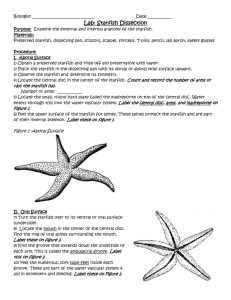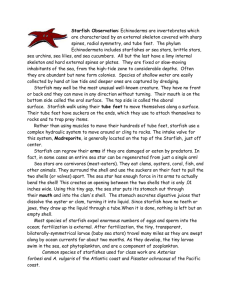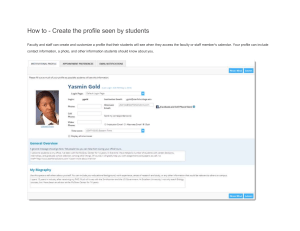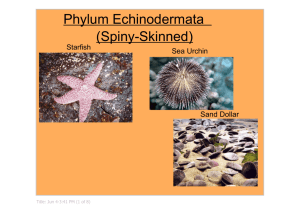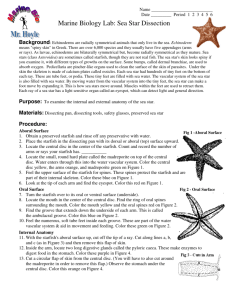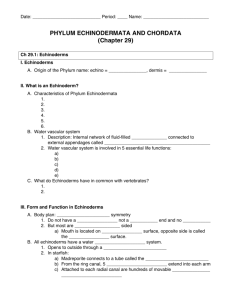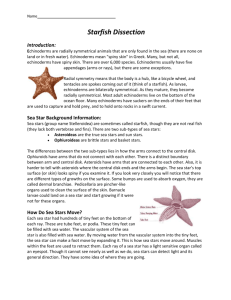Biology - Central Lyon CSD
advertisement
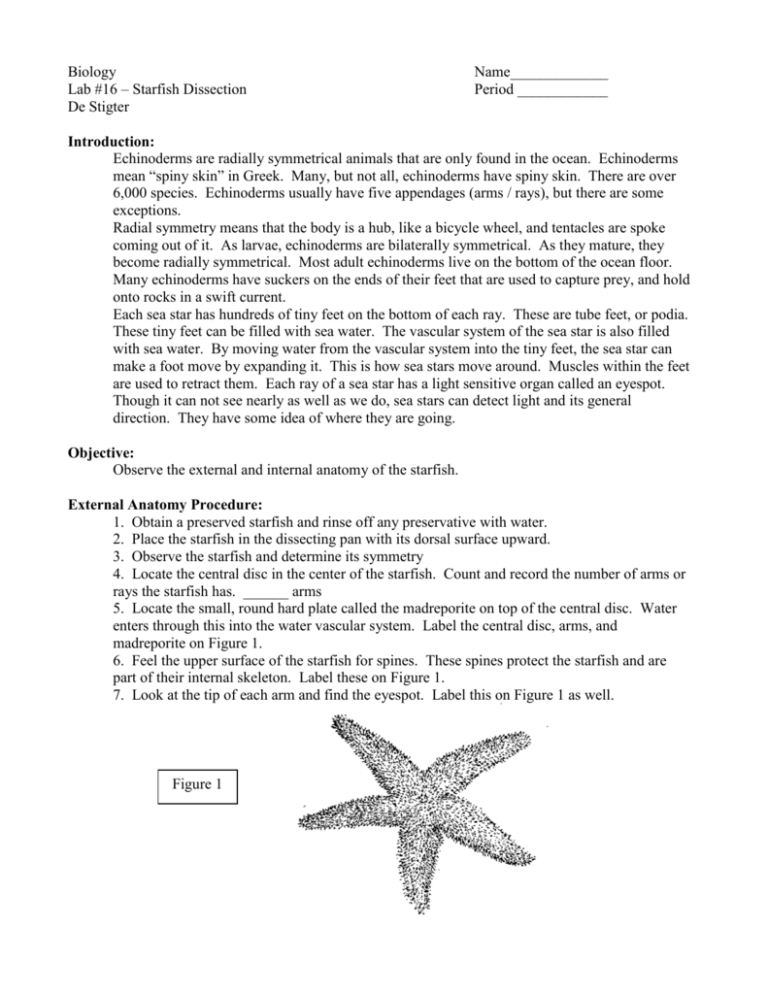
Biology Lab #16 – Starfish Dissection De Stigter Name_____________ Period ____________ Introduction: Echinoderms are radially symmetrical animals that are only found in the ocean. Echinoderms mean “spiny skin” in Greek. Many, but not all, echinoderms have spiny skin. There are over 6,000 species. Echinoderms usually have five appendages (arms / rays), but there are some exceptions. Radial symmetry means that the body is a hub, like a bicycle wheel, and tentacles are spoke coming out of it. As larvae, echinoderms are bilaterally symmetrical. As they mature, they become radially symmetrical. Most adult echinoderms live on the bottom of the ocean floor. Many echinoderms have suckers on the ends of their feet that are used to capture prey, and hold onto rocks in a swift current. Each sea star has hundreds of tiny feet on the bottom of each ray. These are tube feet, or podia. These tiny feet can be filled with sea water. The vascular system of the sea star is also filled with sea water. By moving water from the vascular system into the tiny feet, the sea star can make a foot move by expanding it. This is how sea stars move around. Muscles within the feet are used to retract them. Each ray of a sea star has a light sensitive organ called an eyespot. Though it can not see nearly as well as we do, sea stars can detect light and its general direction. They have some idea of where they are going. Objective: Observe the external and internal anatomy of the starfish. External Anatomy Procedure: 1. Obtain a preserved starfish and rinse off any preservative with water. 2. Place the starfish in the dissecting pan with its dorsal surface upward. 3. Observe the starfish and determine its symmetry 4. Locate the central disc in the center of the starfish. Count and record the number of arms or rays the starfish has. ______ arms 5. Locate the small, round hard plate called the madreporite on top of the central disc. Water enters through this into the water vascular system. Label the central disc, arms, and madreporite on Figure 1. 6. Feel the upper surface of the starfish for spines. These spines protect the starfish and are part of their internal skeleton. Label these on Figure 1. 7. Look at the tip of each arm and find the eyespot. Label this on Figure 1 as well. Figure 1 8. Now turn the starfish over to its ventral side. Locate the mouth in the center of the central disc. Find the ring of oral spines surrounding the mouth. Label these on Figure 2. 9. Find the groove that extends down the underside of each arm. This is called the ambulacral groove. Label this on Figure 2. 10. Feel the numerous, soft tube feet inside each groove. These are part of the water vascular system and aid in movement and feeding. Label these on Figure 2. Figure 2 Internal Anatomy Procedure: 11. With the starfish’s dorsal surface facing you, cut off the tip of a ray. Cut along lines a, b, and c (Figure 3) and then remove this flap of skin. Figure 3 12. Inside each arm, locate two long digestive glands called pyloric caeca. These make enzymes to digest food in the stomach. Label these in Figure 4. 13. Cut a circular flap of skin from the central disc. (You will have to also cut around the madreporite in order to remove this flap.) Observe the stomach under the central disc. Label this on figure 4. 14. Remove the pyloric caeca from the dissected ray. Find the gonads (Testes or ovaries) underneath. These may be small if the starfish is not in breeding season. Label this on figure 4. Remove these to see the rest of the water vascular system. 15. Cut off the tip of a ray to observe the parts of the tube feet. Find the zipper-like ridge that extends the length of the ray. The tube feet are attached to these. 16. Locate the bulb-like top of a tube foot called the ampulla. This sac works like the top of an eyedropper to create suction. The bottom of the tube foot is a sucker. Label these in figure 4. 17. Embedded in the soft body wall are skeletal plates called ossicles. Locate these and label them in figure 4. Figure 4 18. Tube feet are attached to small lateral canals. The lateral canal is connected to the radial canal which runs lengthwise of each arm. Label these in Figure 5. 19. In the central disc the five radial canals connect to a circular canal called the ring canal. Find this canal and label it on figure 5. 20. A short, canal called the stone canal leads from the ring canal to the madreporite where water enters. Find this canal and label the stone canal and madreporite on figure 5. 21. Draw an arrow on figure 5 tracing the path that water takes when it enters and move through the starfish. Figure 5 Post Lab Questions: 1. What type of symmetry did your starfish have? 2. What is the upper surface of the starfish called? 3. What is the lower surface of the starfish called? 4. On which surface are these parts of a starfish visible (use directional anatomy) a. mouth b. madreporite c. suckers d. oral spines e. eyespots f. ambulcaral groove 5. In your own words, trace the path water takes through the water vascular system. 6. Why do the gonads sometimes appear larger? 7. What type of skeleton, endoskeleton or exoskeleton, does the starfish have? 8. What bony plates make up its skeleton? 9. What is the function of the pyloric caeca? 10. Where is the stomach of a starfish located? What can the starfish do with its stomach when feeding on clams and oysters? 11. Name the kingdom, phylum, and class for the starfish you dissected.

